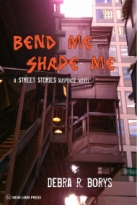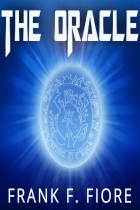Debra R. Borys has over ten years freelancing experience ranging from fiction to articles, feature stories, press releases and radio spots. I interviewed Debra last year on Literature & Fiction. She has joined us today to talk about her latest novel, Bend Me, Shape Me.
Please tell everyone a little about yourself, Debra.
 Debra: I recently returned to small town Illinois to be closer to family, but I spent over fifteen years living in Chicago and then Seattle where I volunteered with organizations that offer services to homeless youth and adults. Getting to know people who live on the streets struggling to survive changed the way I think of them and sparked an interest in creating my Street Stories suspense series.
Debra: I recently returned to small town Illinois to be closer to family, but I spent over fifteen years living in Chicago and then Seattle where I volunteered with organizations that offer services to homeless youth and adults. Getting to know people who live on the streets struggling to survive changed the way I think of them and sparked an interest in creating my Street Stories suspense series.
I have been a serious writer all of my adult life and have had several short stories published in addition to the first novel in the Stories series, Painted Black. I operate an on-again/off-again freelance writing and editing business that helps fill in my time and pay a few bills. I have two grown sons and an adorable mixed breed small dog named Sophie who enjoys keeping me company by the computer.
When you started writing, what goals did you want to accomplish? Is there a message you want readers to grasp?
Debra: With the Street Stories series I wanted to create an awareness of the people who are homeless. Too often we walk by without looking at the person standing on the street corner or if we do notice we jump to negative conclusions about who that person is. There are a wide variety of people living on the streets and they all have different stories to tell. While the stories in my novels are fiction, they are based on reality. If you find my characters interesting, I guarantee you will find the real people you can meet on the street or at the shelters even more enjoyable and surprising.
Briefly tell us about your latest book.
 Debra: In Bend Me, Shape Me, Snow Ramirez is convinced psychiatrist Mordechai Levinson is responsible for one kid’s suicide and is targeting her brother as his next victim. But no one will listen to a seventeen-year-old street kid, especially one diagnosed as bi-polar. When her squat mate Blitz slits his own throat in front of her, she knows it’s time to convince someone to trust her instincts.
Debra: In Bend Me, Shape Me, Snow Ramirez is convinced psychiatrist Mordechai Levinson is responsible for one kid’s suicide and is targeting her brother as his next victim. But no one will listen to a seventeen-year-old street kid, especially one diagnosed as bi-polar. When her squat mate Blitz slits his own throat in front of her, she knows it’s time to convince someone to trust her instincts.
Once again, reporter Jo Sullivan finds herself the only person willing to listen to one of Chicago’s throwaway youth. Helping out kids less fortunate than herself keeps her mind off her conflicted feelings toward her father and his battle with lung cancer. To save Snow, however, she risks her own life in an unexpected twist of events.
What’s the hook for the book?
Debra: My plots are inspired by real life news stories. For Bend Me, Shape Me an article about a family suing their son’s psychiatrist planted the germ of an idea. Their autistic son had been exhibiting violent and dangerous behavior after beginning treatment and because the family insisted on further investigation, the police discovered the doctor was actually a paranoid schizophrenic who planned to brainwash his patients into becoming his own private security force. I simply asked myself “What if?” What if the patient had no family, no one who cared what happened to him? What might the end result have been? For me, the end result was this book.
How do you develop characters?
Debra: The street characters in the series are inspired by the people I met on the streets of Chicago. In some cases, they are loosely based on specific encounters I had, or may be composites of people My protagonist Jo Sullivan is much more negative and dark than I am, but she shares the same concern for helping the homeless and has a thing for tequila, like me.
Who’s the most unusual/most likeable character?
Debra: People will be able to identify with Jo the easiest, simply because she is the more “normal” character in the way she thinks. What’s more, she cares and her caring draws the reader into that same emotion. But it is Snow who seems to grab the most attention from readers. As one reviewer put it: “Snow is strong, brave, troubled and incredibly fierce. Watching her open up and trust was profound.” “Snow is a powerful character who has been a part of too much darkness for a girl of eighteen. She is street wise and has spent her youth protecting her brother Alley and drowning her sorrow in pills.”
Do you have specific techniques to help you maintain the course of the plot?
Debra: For this book I started using Microsoft’s OneNote to keep track of plot, characters and research. I created a notebook for the series and then created tabs that will relate to all books in the series, such as Characters, Locations, Research, etc. Each tab can have many pages; for instance, each character has his or her own page where I can keep track of their traits and background stories. The tabs can also be grouped into sections, so I create a section for each novel with one page for each chapter where I summarize what is to happen and also record notes and checkpoints I want to remember to go back and look at later. You can create multiple notebooks for projects and I have begun one for a new cozy mystery series I am working on currently.
Share the best review (or a portion) that you’ve ever had.
Debra: I’ve been very pleased with the reviews of Bend Me, Shape Me so far. The review excerpts posted below are typical of what’s been said across the board
“Borys offers fascinating characters, a look at inner city homeless children and combines it with a suspenseful mystery that kept me flipping the pages….The pace slowly built towards the climatic conclusion keeping me engaged. Borys did an excellent job of bringing all of the threads together.” — via Caffeinated Book Reviewer
“True to Borys style you get a very surreal feeling of what life on the streets is really like. It’s gritty, dirty, frightening, and cold. She portrays this life effortlessly, and before long you’re pulled into this harsh life these kids live. The plot moves along at a good pace throughout the story, slowing and spiking at just the right points, and the characters are fleshed out so well that you immediately feel a connection to them – even if you’ve never lived the same kind of life.” — via Darian Wilk.
“The author uses vivid imagery that will stay with the reader, and may even haunt you a little when you’re done reading. These books have definitely caught my attention and I can’t wait to see what comes next.” — via Jenn’s Review Blog
What are your current projects?
Debra: Because I recently moved back to small town Illinois where I was raised, and also to do something a little lighter in tone, I am writing a cozy mystery which I hope will turn into a series. The title is A Bull By The Horns and in it a country wife who is the caretaker of an art colony established on a working farm tries to solve the murder of a famous literary writer. Or is he? Suspects include a painter, composer, poet and mystery author, as well as an irascible old neighbor upset at the establishment of such an “artsy, fartsy” community a mere five miles from his doorstep.
Where can folks learn more about your books and events?
Debra: Details and news are always available at my websites: http://www.Debra-R-Borys.com and http://www.StreetStoriesSuspenseNovels.com.
I also have sites set up for each book where you can read the reviews and any news about events: www.BendMeShapeMe.net and www.PaintedBlackNovel.com .
You can walk into your local bookstore and ask them to order you a copy of either book. If you prefer online shopping, both print and ebooks are available at Amazon.com and BarnesandNoble.com, and ebooks can be also purchased at Kobo.com
Thanks for joining us today, Debra.
Debra Thank you for this chance to share my work with your readers again.



















 Stumble It!
Stumble It!

